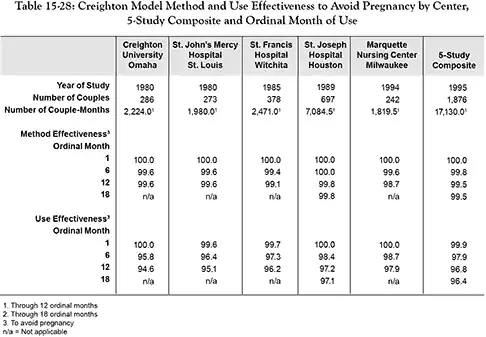The Creighton Method of NFP is fairly effective, but in lab research not quite as effective as the market copy with perfect use.
Use effectiveness of the Creighton model ovulation method of natural family planning
RESULTS:
At 12 months of use, the Creighton model was 98.8% method effective and 98.0% use effective in avoiding pregnancy. It was 24.4% use effective in achieving pregnancy. The continuation rate for the sample at 12 months of use was 78.0%.
CONCLUSION:
The Creighton model is an effective method of family planning when used to avoid or achieve pregnancy. However, its effectiveness depends on its being taught by qualified teachers. The effectiveness rate of the Creighton model is based on the assumption that if couples knowingly use the female partner's days of fertility for genital intercourse, they are using the method to achieve pregnancy.
My wife and I use the Creighton method. We asked our teacher about the disparity between the two figures, and were told that part of it is the same problem that most birth control methods have, that one or both parties might intentionally or unintentionally fudge the results. The Creighton Institute adjusts their figures based on data from the teachers, who are more likely to be told by one of the users that the intentionally misread a chart because they want a child, or that they'd been following the method exactly except for that one vacation where they filled it in afterwards and might have shaded towards assuming that they were not fertile even though the signs were there.
For what it is worth, the Creighton Institute's figures are available in a chart here.

Regrettably, it doesn't look like anyone has published results of a study of efficacy since the late 1990s. And, of course, you run into the same issues as in Does natural family planning decrease divorce rates? where the demographic who uses the method are heavily skewed toward one end.
